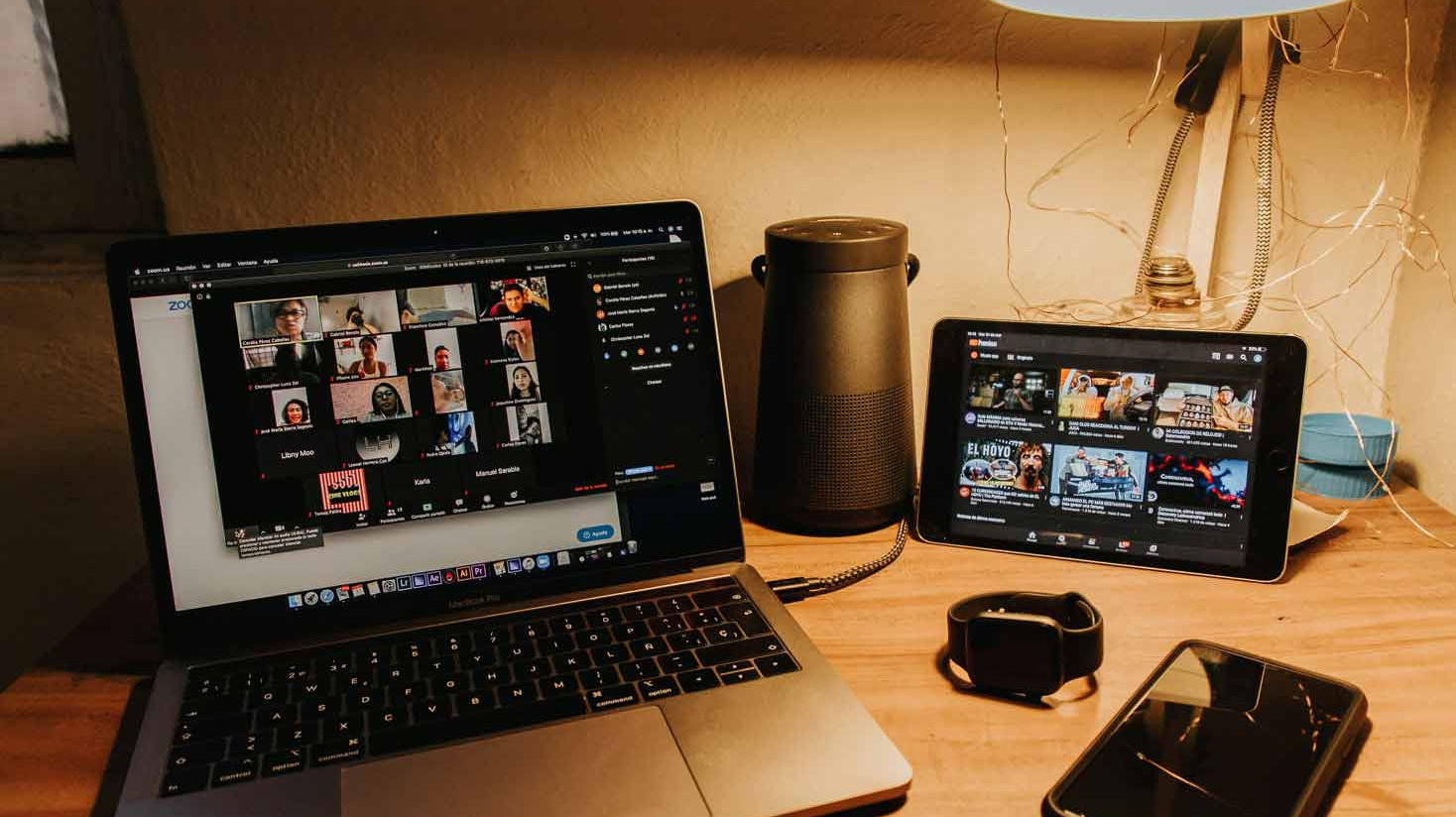Augmented Reality
January 2024
Explore Zoom's VisionOS & How its Revolutionising Virtual Meetings with AR

Zoom and Apple have recently announced an exciting partnership set to transform the landscape of virtual meetings and remote collaboration, with its latest launch of its innovative VisionOS app, a pioneering platform designed exclusively for Apple's Vision Pro headset. This partnership marks a significant leap in technological integration, marrying Zoom's expertise in virtual communication with Apple's cutting-edge augmented reality (AR) capabilities. Set for release on February 2nd, this collaboration promises to introduce a suite of advanced features that will redefine the way we connect, collaborate, and engage in the digital workspace.
A key innovation in Zoom's VisionOS, designed for the Apple Vision Pro headset, is the introduction of the "persona" feature, enabling users to represent themselves by digital avatars during Zoom calls. Essentially, these personas are sophisticated digital versions of the users, crafted to represent them in virtual meetings. When you engage in a Zoom call using the Apple Vision Pro headset, your persona - a digital avatar - appears in place of your live video feed. This avatar is more than just a static image; it is a dynamic representation that mimics your facial and hand movements in real time, thanks to the advanced scanning technology of Vision Pro. This feature not only adds a layer of personalisation to virtual meetings but also enhances the realism and interactivity of online interactions, making remote communication more engaging and expressive.
The Apple Vision Pro headset, priced at £2,764, will offer access to nearly 200 apps, including popular streaming services. However, the absence of apps like Netflix, Spotify, and YouTube highlights some industry hesitance.
Leveraging AR Technology for Enhanced Meeting Experiences
Zoom's integration with the Apple Vision Pro headset brings a revolutionary approach to virtual meetings through the utilisation of augmented reality (AR) technology. This advanced feature transforms the way users experience video calls, offering an unprecedented level of immersion and interactivity.
- Augmented Reality in Action: The AR capabilities of the Apple Vision Pro headset allow Zoom to present video calls not just on a screen but as a floating window in the user's physical space. Imagine seeing your colleagues' faces or presentation materials hovering in your room, as if they are right there with you. This creates a sense of presence that traditional video calls simply cannot match.
- Customisable Virtual Environments - The power of AR technology extends beyond just floating windows. Users can customise their virtual environment. Whether it's placing a digital whiteboard in your workspace or arranging virtual screens around you, the flexibility of AR ensures that each user can create a setup that best suits their needs and enhances their productivity.
- Interactivity and Collaboration - AR in Zoom calls opens up new avenues for interaction and collaboration. Participants can point, gesture, and interact with shared 3D objects or data in real-time. This feature makes remote meetings more dynamic and engaging, fostering a collaborative atmosphere that mirrors in-person interactions.
- Blurring the Lines Between Physical and Digital - By leveraging AR, Zoom and the Apple Vision Pro are blurring the lines between physical and digital spaces. This not only enhances the realism of remote communications but also introduces new possibilities for presentations, workshops, and collaborative work sessions. It's a step towards a future where the distinction between being physically present and joining virtually becomes increasingly seamless.
- Accessibility and Ease of Use: Despite its advanced technology, the AR feature is designed with user-friendliness in mind. It's intuitive and easy to use, ensuring that even those new to AR can quickly adapt and make the most out of their virtual meetings.
- A Glimpse into the Future of Remote Interaction: This implementation of AR technology is just a glimpse into the potential future of remote interaction. As the technology evolves, we can expect even more innovative features that further enhance virtual communication, making it more efficient, engaging, and close to the real-life experience.
User Concerns about the Persona Feature:
While the persona feature in Zoom's VisionOS app for the Apple Vision Pro headset introduces an innovative way to represent oneself in virtual meetings, it has also raised some concerns among users. These concerns primarily revolve around the practicality and maintenance of these digital avatars.
- Constant Updating of Avatars: A significant worry is the need for users to frequently update their avatars to reflect their current appearance. Users question the feasibility of regularly altering their digital persona to match changes in their real-world appearance, such as hairstyle modifications or facial hair growth. This constant updating could become a cumbersome task, especially for those who use Zoom frequently for professional meetings.
- Authenticity in Meetings: Another concern is the loss of authenticity in meetings. Part of the appeal of video calls is the ability to see people as they currently are, which fosters a sense of connection and authenticity. With pre-set digital avatars, there's a risk that this personal touch might be lost. Users are questioning whether this feature, intended to enhance the virtual meeting experience, might instead detract from the genuine human interaction that video calls currently offer.
- Professional Implications: In a professional context, one also considers how one's avatar is perceived. Users may feel pressured to maintain professionalism in their avatar's appearance, which could lead to additional stress and time spent on managing their digital persona.
To address these concerns, Zoom could consider implementing more user-friendly avatar customisation tools, making it easier and quicker to update avatars. Additionally, offering a range of preset avatars that can be quickly adjusted to reflect minor appearance changes could be a practical solution. Another approach could be the integration of AI technology that automatically updates the user's avatar based on periodic scans, reducing the need for manual updates.
It's crucial for Zoom to actively seek and incorporate user feedback on the persona feature. By understanding user preferences and concerns, Zoom can iterate on this feature to ensure it adds value to the virtual meeting experience without becoming a hindrance.
Enjoying what you're reading?
See our workExciting Upcoming Features: Real-World Pinning, Team Chat, and 3D Interface
Zoom's VisionOS app is gearing up to introduce a series of innovative features later this spring and is poised to redefine the landscape of virtual collaboration.
- Real-World Pinning - One of the most anticipated features is "real-world pinning." This cutting-edge technology allows users to remove the backgrounds of other meeting participants and seamlessly integrate them into their physical environment. Imagine having a virtual meeting where your colleagues appear to be sitting across the table from you, or a client presentation where the presenter seems to be standing right in your office. This feature not only enhances the realism of virtual meetings but also aids in creating a more focused and engaging interaction, as it reduces the distractions often associated with remote communication.
- Team Chat - In response to the growing need for efficient team communication tools, Zoom is introducing "Team Chat," which is set to compete with established platforms like Slack. Team Chat is designed to streamline communication within teams, offering features like instant messaging, file sharing, and task management. This integration within the Zoom ecosystem means that teams can now have seamless communication before, during, and after meetings, ensuring that information flow is smooth and uninterrupted. The potential for this tool to enhance collaboration and increase productivity in remote and hybrid work environments is immense.
- A New Dimension with 3D Interface - Another groundbreaking addition is the 3D interface capability of VisionOS. While not immediately available at launch, Zoom plans to roll this feature out later in the spring. The ability to share and interact with 3D files in real time within a meeting environment opens up vast possibilities for collaboration. This feature is particularly advantageous for industries like game design, architecture, and engineering, where detailed visualisations are crucial. Designers, for instance, can share and collectively review 3D character models or architectural designs in a shared virtual space, enhancing clarity and teamwork.
- Enhancing Creative Collaboration: The introduction of 3D file sharing is more than just a technical advancement; it's a step towards fostering a more interactive and creative collaborative process. Teams can not only view but also manipulate 3D models in real time, allowing for a more dynamic and engaging design and review process. This feature is set to revolutionise how professionals collaborate on complex projects, making the process more efficient and intuitive.
These upcoming features mark important advancements in the Zoom platform, contributing significantly to the evolution of virtual collaboration. In an era where remote work is becoming more common, these tools are expected to play a key role in enhancing the integration of physical and virtual workspaces, leading to improved connectivity and efficiency in our work environments.
Embracing the Future of Virtual Collaboration - Our Final Thoughts
As we approach the exciting launch of Zoom's VisionOS app for the Apple Vision Pro headset, it's clear that the landscape of virtual meetings and remote collaboration is poised for a transformative shift. VisionOS, with its groundbreaking features, is not just a technological advancement; it's a leap towards redefining how we connect, collaborate, and create in the digital era.
The introduction of the persona feature marks a significant move towards more personalised and engaging virtual interactions. The augmented reality (AR) capabilities of the Apple Vision Pro headset, combined with features like 3D object sharing and real-world pinning, are set to enhance the realism and immersion of online meetings. These innovations promise to make remote interactions nearly as nuanced and effective as in-person meetings.
Looking ahead, these technologies are likely to reshape workplace dynamics significantly. The ability to share and manipulate 3D objects in real time could revolutionise fields like design, engineering, and education. Meanwhile, the persona feature, despite its initial concerns, has the potential to introduce a new layer of flexibility and creativity in professional presentations and communications.
As we integrate these technologies into daily use, user feedback will be crucial in shaping their evolution. Zoom's commitment to refining features like persona customisation in response to user needs indicates a future where technology adapts to human preferences, rather than the other way around.
The upcoming launch of these innovative features is set to enrich our virtual meeting experience. As we integrate these advancements, the distinction between physical and digital interactions will subtly evolve, improving our capacity for connection, sharing and teamwork.
Enjoyed This Tech Insight?
Don't miss out on the latest trends and developments by subscribing to our Tech Roundup Newsletter where every two weeks, we share the biggest tech headlines from around the world.
Make sure to subscribe here!
